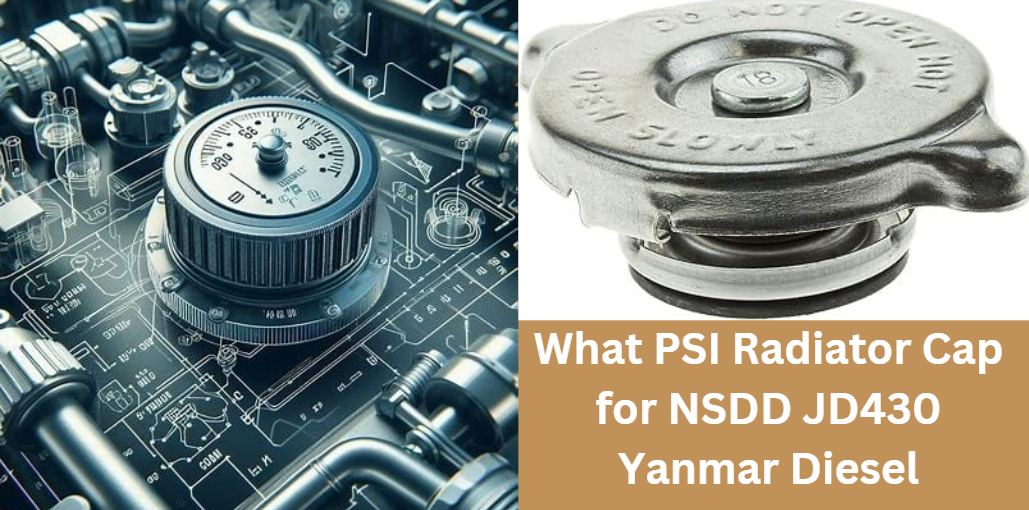Ultimate Guide: What PSI Radiator Cap for NSDD JD430 Yanmar Diesel
The NSDD JD430 Yanmar Diesel engine is known for its robust performance and reliability in demanding applications. One of the critical components that ensure the engine operates within its safe temperature range is the radiator cap. The pressure maintained by the cap, measured in PSI (pounds per square inch), plays a pivotal role in elevating the boiling point of the coolant, preventing overheating, and protecting the engine.
In this guide, we will answer the question: What PSI Radiator Cap for NSDD JD430 Yanmar Diesel is most appropriate? Our goal is to equip you with all the necessary information to make an informed decision and maintain your engine effectively.
Understanding Radiator Caps and PSI Ratings
Before diving into the specifics for the NSDD JD430, it is essential to understand the basic concepts behind radiator caps and PSI ratings.
What is PSI?
PSI stands for pounds per square inch and is a unit of pressure. In the context of an engine’s cooling system, the radiator cap is responsible for maintaining a specific pressure that raises the coolant’s boiling point. This increased boiling point is crucial because it prevents the coolant from vaporizing too soon, which could lead to overheating and engine damage.
How Radiator Caps Work in a Cooling System
The radiator cap is not merely a cover; it acts as a pressure valve. When the engine heats up and the coolant expands, the cap holds the coolant under pressure. If the pressure exceeds the cap’s rating, a safety valve opens, releasing excess pressure and directing it to the expansion tank. This mechanism ensures that the coolant remains effective at absorbing heat while also safeguarding the engine from potentially harmful pressure build-up.
The Role of PSI in Engine Efficiency and Safety
For engines like the NSDD JD430 Yanmar Diesel, maintaining the proper PSI is crucial. The radiator cap’s PSI rating directly influences the operating temperature of the coolant. A higher PSI rating increases the boiling point of the coolant, which can be advantageous under heavy-duty operation.
However, using a cap with too high a PSI may stress the cooling system. On the other hand, a cap with too low a PSI might allow coolant to boil over, reducing efficiency and increasing the risk of damage.
Detailed Analysis: What PSI Radiator Cap for NSDD JD430 Yanmar Diesel
In addressing What PSI Radiator Cap for NSDD JD430 Yanmar Diesel is optimal, it is important to consider both OEM recommendations and practical field experience.
OEM Recommendations and Industry Standards
Manufacturers of Yanmar diesel engines typically recommend a radiator cap with a 13 PSI rating. This specification is derived from rigorous testing and ensures that the engine maintains the correct coolant pressure, allowing the coolant to work effectively under high temperatures.
Although there have been instances where users have experimented with 7 PSI caps, these alternatives often fall short in maintaining the necessary pressure, potentially leading to issues such as coolant overflow or insufficient boiling point elevation.
Technical Breakdown: 13 PSI vs. 7 PSI Caps
A clear understanding of the differences between a 13 PSI and a 7 PSI cap is crucial. The table below summarizes the key distinctions:
| Feature | 13 PSI Cap | 7 PSI Cap |
|---|---|---|
| Pressure Maintenance | Maintains optimal pressure for high-performance cooling | Lower pressure, risking coolant boil-over under heavy load |
| OEM Compatibility | Meets OEM specifications for NSDD JD430 Yanmar Diesel | Not typically recommended by OEM standards |
| Impact on Cooling Efficiency | Elevates the coolant boiling point effectively | May lead to inconsistent coolant performance |
From the table, it is evident that a 13 PSI radiator cap is better suited to the NSDD JD430 Yanmar Diesel engine, ensuring that the cooling system performs reliably under demanding conditions.
User Experiences and Field Reports
Many engine operators and technicians have confirmed that sticking to the OEM recommendation of a 13 PSI cap results in more stable engine temperatures and fewer cooling system issues. Field reports indicate that although some have used 7 PSI caps without immediate failure, the long-term reliability and efficiency of the engine are best supported by the higher pressure cap.
Cooling System Overview for the NSDD JD430 Yanmar Diesel
Understanding how the radiator cap fits into the broader cooling system is essential for proper maintenance. The cooling system in the NSDD JD430 Yanmar Diesel engine consists of several interdependent components, including the radiator, water pump, thermostat, hoses, and of course, the radiator cap.
The radiator cap ensures that the coolant remains in a closed system until the pressure reaches the cap’s threshold. Once this threshold is exceeded, the cap’s pressure relief mechanism activates, allowing excess pressure to escape into the expansion tank. This cycle helps maintain a consistent and efficient temperature range for the engine. If the cap does not maintain the proper PSI, the balance of this system is disturbed, leading to potential overheating or premature coolant loss.
Step-by-Step Guide: Checking and Replacing Your Radiator Cap
Replacing the radiator cap on your NSDD JD430 Yanmar Diesel engine is a task that can be accomplished with minimal tools and a bit of care. Before beginning, it is essential to ensure that the engine is completely cool to avoid burns.
- Preparation and Safety:
Begin by allowing the engine to cool down completely. Gather necessary tools such as a wrench, a clean cloth, and protective gloves. This ensures a safe work environment and prevents injuries. - Removing the Old Cap:
Locate the radiator cap on your engine’s cooling system. Carefully twist the cap counterclockwise to release it. Inspect the removed cap for signs of damage such as cracks, corrosion, or worn-out seals. Documenting these signs can help diagnose any related cooling system issues. - Installing the New 13 PSI Cap:
Once the old cap is removed and the cooling system is inspected, align the new 13 PSI cap with the radiator neck. Twist it clockwise until it is securely fastened. It is crucial that the cap fits snugly to maintain the required system pressure. After installation, run the engine and allow it to reach operating temperature. Monitor the system for any leaks or abnormal pressure releases. - Testing and Verification:
Utilize a pressure tester if available to verify that the radiator cap is maintaining the appropriate 13 PSI. This step confirms that the cooling system will perform effectively during operation.
Troubleshooting and Maintenance Tips
Even with the correct cap in place, periodic maintenance is key to ensuring long-term engine performance. If you notice signs such as coolant leakage, engine overheating, or a loss of system pressure, it is important to diagnose the issue promptly.
Regular maintenance should include:
- Routine Inspections: Regularly check the radiator cap, hoses, and coolant levels. Ensure that all components are free from damage.
- Pressure Testing: Use a pressure tester periodically to verify that the radiator cap maintains the correct 13 PSI.
- Coolant Quality: Replace the coolant as per manufacturer recommendations to prevent degradation and maintain efficient heat transfer.
By following these practices, you can prevent many common issues and extend the life of your engine’s cooling system.
Expert Insights and Industry Perspectives
The recommendation for a 13 PSI cap comes from extensive technical research and industry experience. Technicians and engine experts frequently highlight the importance of using OEM-specified parts to maintain system integrity.
In various technical forums and review platforms, experts have shared that deviations from the OEM standard, such as using a 7 PSI cap, can lead to inconsistent engine performance and potential long-term damage. Interviews with seasoned mechanics reveal that while alternative caps might seem viable in the short term, the consistent performance of a 13 PSI cap is backed by rigorous testing and user feedback.
Frequently Asked Questions (FAQ)
1. Does the engine’s operating environment influence the choice of a radiator cap?
Environmental factors such as extreme ambient temperatures or high-humidity conditions can affect how a cooling system performs. In regions with very high temperatures, the pressure dynamics inside the cooling system might be more stressed. Choosing the proper radiator cap, in accordance with OEM recommendations, helps ensure that the coolant maintains its efficacy regardless of the operating environment. Although the guide focuses on maintaining a 13 PSI rating, understanding how climate impacts the system further justifies using the correct cap.
2. How does the radiator cap affect engine performance during heavy-duty or prolonged operation?
Under heavy load or continuous operation, engines experience higher internal temperatures and increased coolant expansion. The radiator cap’s role becomes even more critical in these situations. A cap rated at 13 PSI helps maintain a stable cooling system pressure, preventing fluctuations that could lead to engine inefficiency or thermal stress. This stability is key to sustaining performance during long work cycles, ensuring the engine remains within its safe operating range.
3. Are there compatibility issues when upgrading other cooling system components along with the radiator cap?
When upgrading or replacing the radiator cap, it is important to consider the compatibility of all cooling system components. For instance, installing a new cap with the correct PSI should ideally be coordinated with checks on hoses, thermostats, and the expansion tank. Ensuring that all parts are in good condition and meet OEM specifications helps avoid any unintended pressure imbalances or system inefficiencies, ultimately supporting the overall health of the engine.
4. What common installation mistakes should be avoided when replacing the radiator cap?
Improper installation can undermine the performance benefits of using the correct 13 PSI cap. Common mistakes include not allowing the engine to cool fully before removal, failing to clean the cap seating area, or not ensuring a tight, secure fit. These oversights can lead to leaks or an inability to maintain proper system pressure. Careful adherence to manufacturer guidelines and a methodical approach to installation can help prevent these issues.
5. How does regular maintenance of the radiator cap contribute to overall engine longevity and fuel efficiency?
Routine checks and timely replacement of the radiator cap are essential for long-term engine health. A well-maintained cap ensures that the cooling system operates at optimal pressure, which in turn keeps the engine at its ideal operating temperature. This not only prolongs the lifespan of engine components but also helps maintain fuel efficiency by preventing the engine from running in extreme thermal conditions. Over time, consistent maintenance can lead to reduced repair costs and better overall performance.
Conclusion
In summary, understanding What PSI Radiator Cap for NSDD JD430 Yanmar Diesel is crucial for maintaining the engine’s cooling efficiency and overall performance. This guide has provided an in-depth exploration of radiator caps, explaining the importance of a 13 PSI rating as recommended by OEM standards, detailing the function and maintenance of the cooling system, and offering practical, step-by-step instructions for replacing the cap.
By following these recommendations and expert insights, you can ensure that your engine remains reliable, efficient, and protected against overheating. Regular inspections, proper maintenance, and adherence to OEM guidelines are key to sustaining optimal performance over the long term.
Recommended posts
Ultimate Guide to ds02 5×4.5 22 q50
Rhythmical Bossa ONJ3: The Ultimate Guide to a New Era of Bossa Nova Fusion
Definitive Guide to tgm-7 saturn 4 ultra settings
The Ultimate Guide to dm108basic: The Ultimate Efficiency Guide
Best Hair Stylist Los Angeles Morgan Zakarin – A Complete Guide






